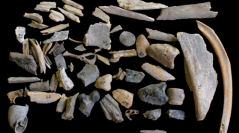

 Anthropozoologica
54 (10) - Pages 83-95
Anthropozoologica
54 (10) - Pages 83-95How prehispanic foragers adjusted their foraging activities to plant cultivation is a question that drives much of the modern archaeological research. As a result, the spread of food-producing economies during the Late Prehispanic Period (c. 1500-360 BP) from Sierras of Córdoba, Argentina, has been recently defined as a dynamic sociocultural process, where a mixed foraging and cultivation economy was accompanied by a flexible land-use strategy. However, the economic organization has only been superficially assessed. Thus, the aim of this article is to present the study of faunal remains recovered during the excavation of the open-air site Boyo Paso 2 in order to provide primary data on the properties of the animal food remains left by late prehispanic people and the characteristics of site occupation. Faunal remains suggest a complex sequence of reoccupations where bones were deposited, accidentally reburned and fragmented by trampling. The diversity of exploited prey also sheds light on the fact that a broad hunting spectrum continued playing a key role in the daily subsistence. Nevertheless, cultigens were a fluctuating component in a diverse foraging economy in which wild resources as guanaco (Lama guanicoe Müller, 1776), small-vertebrates and Rheidae eggs continued to be extensively used. The study of Boyo Paso 2 faunal assemblage is relevant because it helps to improve the current understanding of the economic importance of foraging wild resources and would constitute a model to interpret other archaeological cases during the Neolithic or Formative transition, where the boundaries between farming and foraging were fluid, but remained relatively invisible according to the existing terminology.
Sierras of Córdoba, Late Prehispanic Period, zooarchaeology, foraging, subsistence, mixed economy.